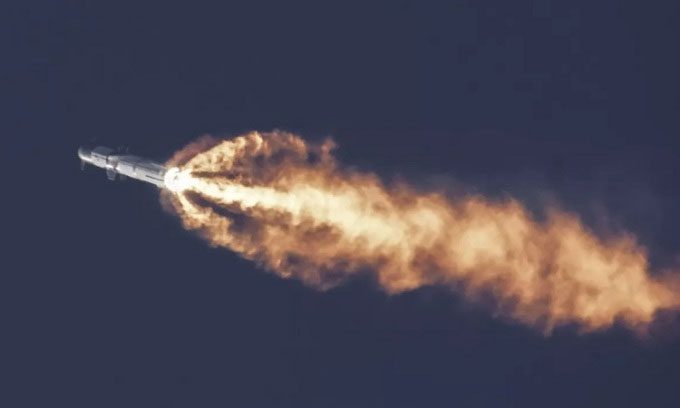Engineers at SpaceX will need to repair the Starbase launch facility while preparing the new Starship vehicle system for its second test flight.
The Starship rocket launched for the first time on April 20 from SpaceX’s Starbase facility in South Texas. The company aimed to send the upper stage of the Starship into space and then land it in the Pacific Ocean near Hawaii. However, the Starship encountered some issues a few minutes after liftoff, leading SpaceX to issue a command to destroy the 120-meter tall vehicle over the Gulf of Mexico, according to Space.

Starship flying over Texas on April 20. (Photo: SpaceX).
Nevertheless, SpaceX emphasized that Starship achieved many milestones during the test flight. For example, the vehicle reached a relatively high altitude, peaking at 39 km above the ground. It also passed through Max-Q, the point at which the pressure on the rocket is at its highest. Elon Musk, the founder and CEO of SpaceX, congratulated the team after the test launch and indicated that the next attempt would take place in the coming months. Musk’s comments reflect a strategy aiming to establish SpaceX as a leading company in the aerospace industry today. This involves manufacturing, testing, and rapidly iterating, learning from failures throughout the process.
However, Musk’s timeline appears to be quite optimistic, as this test flight caused significant damage to the launch infrastructure and some support systems. SpaceX has yet to release post-event images of the Starship launch pad, but reliable sources indicate that the damage caused by the 33 Raptor engines on the first stage of Starship is substantial.
According to Spaceflight Now, the launch created a large crater on the concrete surface beneath the launch pad. The orbital launch platform also suffered severe damage. Photographer Max Evans from NASASpaceflight.com stated that it is hard to imagine this area could be reused within the next 12 months. Engineer and entrepreneur Jonathan Goff, co-founder of Masten Space Systems and Altius Space Systems, also believes that it will take at least 7 to 9 more months for Starship to conduct its next flight. However, in comments made on April 22, Musk stated that SpaceX could be ready to launch in 1 to 2 months.
The American billionaire noted that the company started constructing a massive water-cooled steel shield beneath the launch pad three months ago. This shield was not ready in time for the launch, but SpaceX proceeded with the mission because they calculated that the concrete layer beneath the Starbase launch pad could withstand the liftoff process. Unfortunately, this calculation turned out to be incorrect. The steel shield will be installed before the second test flight of Starship.
The team in charge of the Starship project at SpaceX will be very busy in the coming weeks. In addition to repairing the Starbase facility and installing the shield, they will need to analyze data from the first flight, draw lessons for future Starship missions, and prepare the next vehicle for flight.


















































